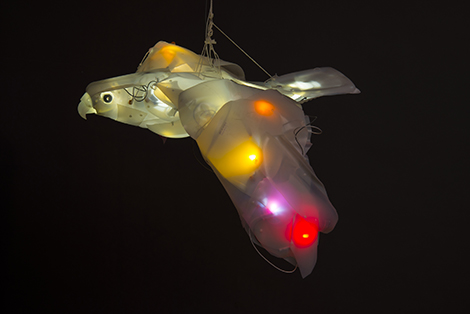he beasts of burden in Cynthia Minet’s conceptually and politically astute project include an elephant, pack dogs and birds of prey (vultures/falcons/raptors). Internally illuminated by LEDs and created from recycled and repurposed plastic fragments of all shapes, sizes and colors, Minet imbues these domesticated animals trained to perform tasks for humans with another purpose. Rather than didactically lament the evils of plastic as a ubiquitous pollutant, Minet creates magnificent aesthetic objects that metaphorically call attention to our dependency on electricity and petrochemicals.
Minet’s carefully crafted mixed-media sculptures of threatened species are also threatening; stoic yet playful and vulnerable. Her life-size elephant (based on an adolescent Asian female) is a collage of mismatched plastic objects—bottles, containers, ducts—in various tones of red, assembled around a PVC armature. Each piece of plastic fits into a chaotic puzzle fleshing out the animal’s form, giving it presence and personality. Visible wires connect red and yellow LEDs that feed the elephant’s internal glow. Minet purposely allows the wires to show as an indicator that the work is dependent on electricity, while also acknowledging the fact that the wires function as lines that trace the contour of the creature. Minet is one of a growing number of environmentally conscious artists who work with plastics. In fact, her sculpture Pack Dogs (2014)was created for the traveling exhibition “Gyre: The Plastic Ocean” that accompanies her solo installation. “Gyre” features the work of more than 25 international artists who explore issues of consumption with respect to plastic and waste. Like the artists in “Gyre,” Minet calls attention to the plastic pollution in the ocean, acknowledging we are the beasts and this is our burden. Our reliance on plastics, petrochemicals and electricity is so all-pervasive that it is impossible to imagine living without these modern conveniences. In her sculptures, Minet illustrates this overabundance through the use of found materials as well as by the fact that to illuminate her sculptures they need to be plugged in.
For Pack Dogs, Minet used all kinds of discarded plastic waste—toys, bottles, household goods, computer parts—to construct five life-sized pack dogs (huskies) connected by wires and attached to a hand-made plastic sled. The work faithfully represents the body position and facial features of these hard-working animals. Minet lets the specifics of the environment—for example the arctic ice and the Aurora Borealis—suggest the tones of the animals’ interior illumination.
Minet’s latest addition to her menagerie of “Unsustainable Creatures” is Predator, a series of raptors: birds of prey that are now used like domesticated farm animals in commercial bird eradication programs in vineyards. Minet’s impeccably realistic, albeit plastic birds are suspended from the gallery ceiling, and tethered to an outlet. They cannot fly free. While Minet calls attention to the notion of predator, as in predator drones, animal predators and human predators, she also suggests through this body of work, that we are all trapped like caged animals, dependent on things that are not infinitely sustainable.




















0 Comments